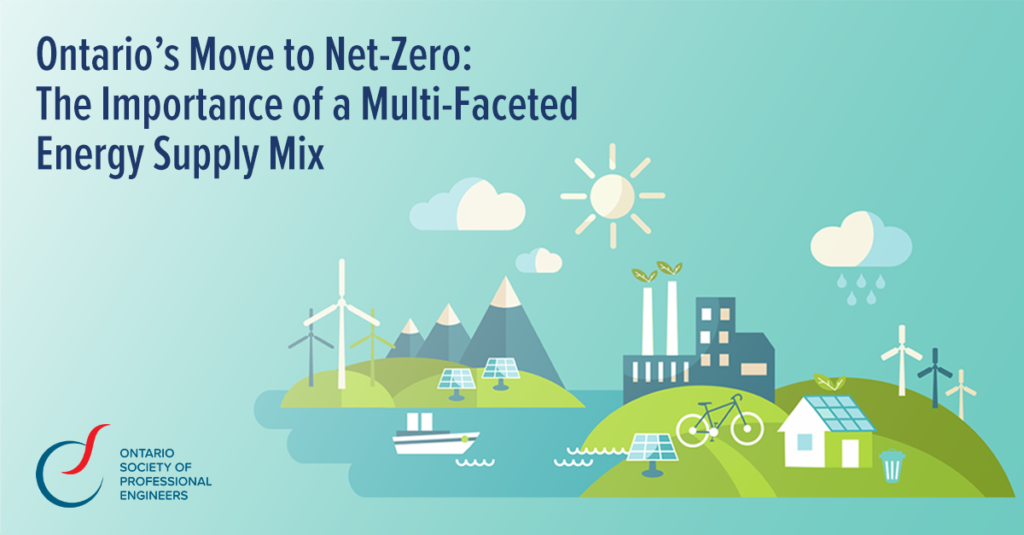
Ontario’s Ministry of Energy recently asked the public for input on their provincial decarbonization strategy, with the goal of achieving net-zero emissions for all energy supplies by 2050 and electricity by 2035. To help the public participate more effectively, OSPE’s Energy Task Force is preparing a series of blog posts on the move to net-zero.
This article – by OSPE Subject Matter Expert Paul Acchione, P.Eng. – is the first in that series. Stay tuned to our digital channels for further commentary on this important topic.
As Ontario moves toward a net-zero energy grid, the most important question on everyone’s mind is: Can we afford zero-emission electricity if consumers also need that electricity to be reliable and resilient?
By reliable, we mean that enough electricity is available at the correct voltage and frequency when the consumer needs it. By resilient, we mean that the electricity supply can withstand severe storms (and/or other disruptions). In an industrialized province with cold winters, like Ontario, relaxing reliability and resiliency requirements to lower retail electricity costs will not be a viable option.
OSPE believes that an optimal mix of various zero-emission energy technologies can achieve net-zero emissions at an affordable consumer cost. However, that financial cost will likely be about double the expense of using only fossil fuels for our energy needs. The reality is that some choices—such as what energy demand we want to electrify and what generation technologies to include or exclude—can dramatically increase the retail cost of our electricity. But one thing is clear: Ontario cannot rely on a single-generation technology to provide affordable zero-emission energy to consumers.
To illustrate the true total cost of providing zero-emission, reliable, and resilient electricity, we can use an example that most will understand.
Suppose we wanted to use only solar energy to achieve net-zero. The contractual cost to make electricity using solar photovoltaic (PV) panels is currently quite reasonable. So, the obvious question is: why do we need other technologies? Well, the simple fact is that the sun does not always shine (and when it does, its energy can only be stored for so long). Also, solar PV output is not well-aligned with the electricity demands of consumers. To bring the supply and demand into balance every second of the day, we would need a significant amount of expensive longer term energy storage so that solar PV electricity can supply electricity to consumers when the sun does not cooperate, especially during severe weather events.
And if we can’t rely on a single technology, what is the optimal mix of energy generation sources? OSPE has run some computer simulations of retail prices for reliable, resilient supply mixes. These simulation cases added additional generation technologies to the existing 2021 installed generation mix. (The 2021 mix was retained in all simulations because many existing generation contracts do not expire until after 2035.)
The simulations demonstrate that a mix of generation technologies results in a lower retail electricity cost compared to using single technologies. The lowest costs were achieved when the baseload (round the clock electricity demand) was provided by dependable base-load zero-emission generation technologies like hydroelectric and nuclear. The incremental daily peak load and system reserve can be more cost effectively provided by various other technologies (including solar PV, wind turbines, zero-emission fuels like renewable natural gas, and modest amounts of electrical storage).
Over the coming weeks, OSPE will continue to provide information on Ontario’s move to a net-zero electricity system. For further context on our supply mix research, consult our complete Electricity Supply Mix Study and review Table 1 below. (Table 1 summarizes the 2035 cost of various supply mixes to meet the 2035 net-zero emission goal.)
Table 1
The 2035 Retail Price of Electricity Using Various Supply Mix Options

Table Notes:
- Emissions for supply mix A and B are 99 kg /MWh CO2
- Natural gas price for Supply Mix A and B is assumed to remain fixed at 5 US$ per million BTU.
- Emissions for all NZ supply mixes are net-zero or 0 kg /MWh CO2
- The $/month is calculated for a typical home using 750 kWh/month of electricity.
- PHS – pumped hydroelectric storage.
- BESS – battery electric storage system.
- All costs are in 2020 dollars.





Leave a Comment